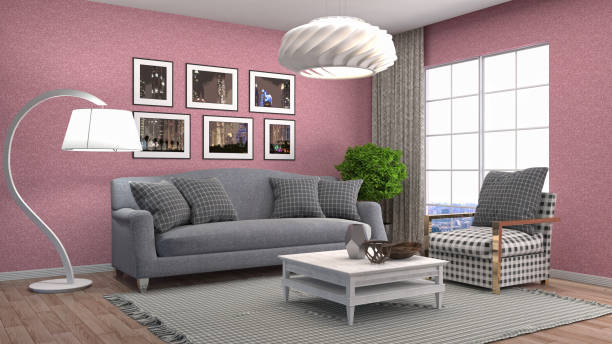One of the most effective elements in interior design Palettes is color, which has the ability to change a room and evoke a variety of feelings. Whether your goal is to create a bright gathering space or a calm haven, mastering the concepts of color harmony is crucial to producing visually arresting home color schemes that elevate the aesthetic appeal of your house.
Let’s examine the art of color harmony in home interiors, from the psychology of color to fashionable combinations and cultural influences, for some stylish home color trends.
The theory of color is the inspiration for all Harmonious color combinations in the design industry, whether they are used in interior design schemes, paintings by artists, graphic design creations, or photo compositions.
The term “color theory” refers to the organized framework, or “bible,” of the art industry that specifies the precise color choices. It helps designers and artists alike effectively communicate their clients’ needs in a form that is visually harmonious and aesthetically acceptable.
One must first comprehend the structure of a color wheel in order to completely comprehend color theory and the creation of color harmonies. The color wheel is made up of twelve pure colors, three primary colors, three secondary colors, and six tertiary colors.
Psychology of Color: Understanding Emotions and Mood Impact
The study of color psychology explores the psychological and emotional impacts that various shades can have on people. Cool tones like blue and green generate sentiments of serenity, tranquility, and relaxation, while warm tones like red and yellow are linked to energy, passion, and warmth.
Whether you’re designing a home office or a comfortable living space, you may create environments that resonate with the desired mood and atmosphere by knowing the psychological impact of color.
Monochromatic Elegance: Mastering the Art of Single Hue Palettes
Using variations of a single hue to create a sophisticated and harmonious palette is known as monochromatic home color schemes. This method allows for small changes in tone and intensity without sacrificing visual coherence, which makes it perfect for creating an elegant and cohesive atmosphere within a place.
Whether you choose gray tones in a modern living room or blue hues in a peaceful bedroom, learning the skill of monochromatic design may give your home’s interiors a classic and elegant look.
Contrast and Balance: Crafting Dynamic Palettes for Visual Interest
Essential components of color harmony include contrast and balance, which contribute to the depth and visual appeal of a room. Complementary hue combinations, like purple and yellow or blue and orange, can produce a striking palette that draws the eye.
In a similar vein, equilibrium is achieved by carefully arranging bright and dark tones so that the eye flows around the space, resulting in a sense of harmony and balance.
Nature-Inspired Hues: Bringing the Outdoors into Home Design
Color palettes can be inspired by nature innumerably, as they provide a wide range of tones and hues that capture the splendor of the natural world. Natural colors, which range from calm blues and sunny yellows to earthy browns and lush greens, infuse house interiors with a feeling of coziness, warmth, and energy.
These natural colors, whether used as accents in the design, upholstery textiles, or paint colors, provide a link to the outside world and give the room a peaceful, calm feeling.
Must Read: Trending mirror frame design ideas for your house
Trendy Harmonious Color Combinations: Staying Current with Contemporary Palettes
You may add a sense of modernity and freshness to your home by sticking to current color schemes. Interior design Palettes trends frequently determine the most in-demand home color schemes that represent contemporary tastes and inclinations.
Trendy color combinations offer countless opportunities to express your particular style and keep your home’s interiors up to date with the newest design trends, from strong and colorful pairings to delicate and subtle contrasts.
Accent Wall Magic: Making a Statement with Strategic Color Choices.
Without overpowering the entire space, accent walls are a potent way to add color and visual interest. You may create a dramatic focal point that anchors the space and adds individuality by carefully choosing a focal wall and painting it in a bold or contrasting tone.
Accent walls provide you the opportunity to express your creativity in home design and create a statement, whether they are decorated with a striking accent hue or a more subdued tone-on-tone appearance.
Cultural Influences
Globally, cultural influences have a big impact on people’s color preferences and palettes. Color schemes and combinations utilized in home interiors are influenced by cultural traditions and aesthetics, as seen in the vivid hues of Moroccan decor and the calm minimalism of Scandinavian design.
Your heritage, passions, and global influences may all be reflected in the spaces you create by taking inspiration from many cultures and design styles.
DIY Color Consultation
You may choose the ideal color scheme for your house hands-on with DIY color consultation, even though working with a professional color consultant can produce great results. To begin, go through magazines, websites, and design blogs for ideas.
Then, play around with paint swatches and samples to see how different colors work with the lighting and décor in your room. Never hesitate to take chances and experiment with different color combinations that express your individuality and sense of style. Instead, trust your gut and personal preferences.
Color Psychology in Different Rooms
Because different rooms have distinct purposes, they should have color schemes that complement those purposes. For instance, calming greens and blues are perfect for bedrooms since they encourage calm and sound sleep, while vibrant yellows and oranges are great for kitchens and dining rooms as they encourage conversation and hunger.
When choosing color schemes, take into account the activities and feelings connected to each space to make sure they improve functionality and provide the right mood.
To sum up, developing beautiful color schemes that improve the aesthetic appeal and practicality of your home’s interior designer requires a mastery of the concept of color harmony.
You may create places that represent your personality, style, and unique vision for your home by learning about the psychology of color, experimenting with monochromatic and contrasting schemes, taking inspiration from nature and culture, and keeping up with current trends. Creating a harmonic balance that satisfies the senses and enhances the quality of life is crucial, regardless of whether you choose big statement hues or calm neutrals.
Must Read: 11 Relevant Window Design Ideas for Every Home & Structure

